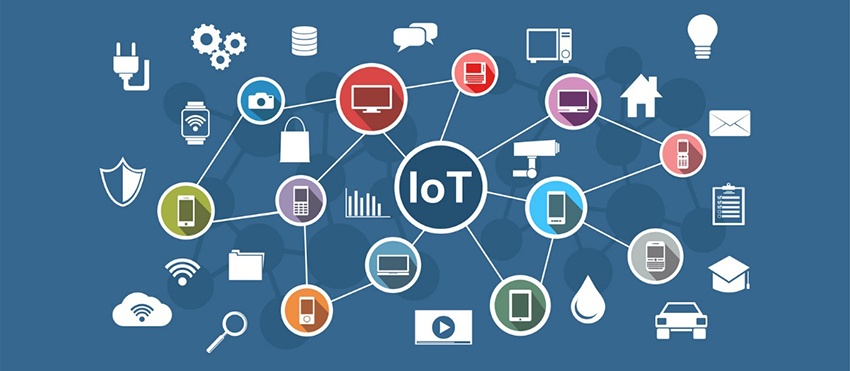
The Internet of Things, or IoT, refers to the billions of physical devices around the world that are now connected to the internet, all collecting and sharing data. Thanks to the arrival of super-cheap computer chips and the ubiquity of wireless networks, it’s possible to turn anything, from something as small as a pill to something as big as an aeroplane, into a part of the IoT. Connecting up all these different objects and adding sensors to them adds a level of digital intelligence to devices that would be otherwise dumb, enabling them to communicate real-time data without involving a human being. The Internet of Things is making the fabric of the world around us more smarter and more responsive, merging the digital and physical universes.
What is the internet of things (IoT)?
The internet of things, or IoT, is a network of interrelated devices that connect and exchange data with other IoT devices and the cloud. IoT devices are typically embedded with technology such as sensors and software and can include mechanical and digital machines and consumer objects.
Increasingly, organizations in a variety of industries are using IoT to operate more efficiently, deliver enhanced customer service, improve decision-making and increase the value of the business.
With IoT, data is transferable over a network without requiring human-to-human or human-to-computer interactions.
A thing in the internet of things can be a person with a heart monitor implant, a farm animal with a biochip transponder, an automobile that has built-in sensors to alert the driver when tire pressure is low, or any other natural or man-made object that can be assigned an Internet Protocol address and is able to transfer data over a network.
How does IoT work?
An IoT ecosystem consists of web-enabled smart devices that use embedded systems — such as processors, sensors and communication hardware — to collect, send and act on data they acquire from their environments.
1. The global IoT market
2014: $2.99 trillion ⇒ 2020: $8.90 trillion
What it means: Well, the $6 trillion surges speaks for itself: There’s a need for all things IoT. And as the IoT technology in products has improved, so has the demand. Data integration from different cyber, physical, and social means in IoT allows for smarter app and service development.
Source: Statista Worldwide Internet of Things Market
2. The number of connected devices worldwide
2018: 23.14 billion ⇒ 2025: 75.44 billion
What it means: Devices are continually offering better design, implementation, and operation for connected systems and ecosystems. And with services growing and as more apps emerge, costs for devices drop while the production jumps.
Source: IOT Number of Connected Devices Worldwide
3. Global number of RFID tags
2018: 17.6 billion ⇒ 2020: 24.5 billion
What it means: What is RFID? It stands for radio-frequency identification. So, what’s that got to do with IoT? Well, IoT has put these tags at the forefront of the supply chain and logistics industries providing real-time insight into the movement of goods and impacting the efficacy and transparency of global trade. RFID tags are embedded with specific information and attached to objects in order to track location and provide visibility to the transfer of the associated product.
Source: Size of the Global RFID Market
4. Worldwide spending on third party connectivity for IoT
2018: $742.6 million ⇒ 2020: $1.18 billion
What it means: Investors will keep pouring cash into IoT projects, which has not only unlocked opportunities for connected business partners but also calls for all devices to be connected at some point.
Source: 3rd Party IOT Connectivity Revenue
5. Number of M2M connections
2018: 1.5 billion ⇒ 2020: 2.6 billion
What it means: M2M (machine-to-machine) technology enables devices to communicate and connect with one another without or very limited human interference. And as stated before, devices will continue to be developed to connect and communicate with other devices in an automated way, sharing information and data.
Source: Global M2M Connections
6. B2B IoT market size
2015: $195 billion ⇒ 2020: $470 billion
What it means: The B2B market segment is projected to drive significant revenue and includes system integration, data services, and analytics, networks, devices, and legacy embedded systems. With the explosion of data and data sources through the B2B ecosystem, organizations will continue to base integration on technologies that deliver multi-enterprise collaboration to maintain communication among partners, customers, suppliers, data lakes, and other external networks.
Source: IOT of Industrials
7. Business investment in IoT
2015: $215 billion ⇒ 2020: $832 billion
What it means: Spending on anything IoT-related has been apparent. So, predicting a $600 billion boom over five years isn’t surprising. Everything from smart home appliances to work automation tools, investing in IoT is almost a given among business practices for companies that want to see growth and an improved bottom line.
8. IoT spending in the transportation and logistics industry
2015: $10 billion ⇒ 2020: $40 billion
What it means: Transportation and logistics companies will obviously keep taking strides in profitability, productivity, and overall operations efficiencies through technological advancement. RFID adoption, often in conjunction with traditional line-of-sight technology offers a potentially data-rich supply chain that leads to insight-based decision making. However, new data sources present new challenges when it comes to accessing, ingesting, and utilizing the data for business purposes. Currently, integration solutions hold a lot of promise for helping address the challenges of IoT. With a mix of existing legacy technology and IoT-specific applications, enterprises can leverage edge computing and data that are transported to a centralized cloud network to enable decentralized, multi-enterprise communications that are vital supply chain and logistics companies.
9. Projected IoT economic impact
Range by 2025: $3.9 trillion ⇔ $11.1 trillion
What it means: With more than $7 trillion dollars between the low and high end of these estimates, the figures highlight the scale of unknown factors in accessing the success and extent of adoption of the Internet of Things. At the high end, $11.1 trillion dollars represents around 11 percent of the world economy, underlining the massive scale of its ultimate impact. The McKinsey forecast includes influences across many global industries and regions. But IoT is benefiting from improvements to technology infrastructures and the ability to more easily connect devices. The McKinsey study adds that power requirements, costs, and the development of more integrated solutions affect projections.
Source: What’s New with the Internet of Things
10. Percentage of enterprises adopting IoT
2017: 30% ⇒ 2020: 65%
What it means: This all comes down to the enterprise’s ability to exploit the Internet of Things for market advantage. First of all, IT and business leaders need to consider the extent to which this type of technology can be utilized to improve ROI, market competitiveness, and brand differentiation. Secondly, as the market matures, questions around the digital security of potentially sensitive personal and corporate data will be addressed. Finally, the internal competency center required to implement and leverage devices will find that the necessary skillset becomes less rare. As a result, adoption is tied to the cost-benefit analysis of the ability to exploit this technology either as a product or as a way to improve the business.
Source: IOT eBook
Read on to find out if your business is ready for the Internet of Things revolution. The Internet of Things (IoT) has gained a tremendous head of steam over the last few years.
